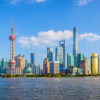Nikko AM Insights
On-the-ground view of post-COVID China
A recent trip to China offered first-hand observations of the country’s technological advancement, changing consumer patterns and new social norms as the world’s second largest economy moves on from the pandemic.
As the developed world continues to struggle with inflation and a lack of growth, Asia stands out as the bright spot, with inflation well in check and monetary cycles peaking ahead of the West. Growth in Asia is also expected to outperform the West over the next few years, reversing a decade-long trend of developed world growth outperformance.
The Demise of the Once Mighty US Dollar?
As an undergraduate economist, the subject of foreign exchange reserves and reserve currencies garnered scant attention because we were in a world of floating currencies in which FX intervention, when it did occur, was only ever modest and temporary. It was only in the mid-1980s, when a number of overtly mercantilist economies in Asia began linking their (frequently undervalued) currencies to the USD and acquiring specie that global reserves became a “topic”. During the 1990s, New Zealand operated without reserves.
Navigating Japan Equities: Monthly Insights from Tokyo (June 2023)
This month we discuss the factors behind the Nikkei’s rise to a 33-year high; we also assess Japan’s opportunity to re-invent itself as a technology hub with leading global chipmakers bringing investments and manufacturing to its shores.
Global Equity Quarterly (Q1 2023)
At times of stress, we believe that it makes sense for investors to reach for something that has recently provided comfort. Our view is that that is exactly what we have seen in Q1, as banking stock volatility has led investors back into the technology sector. Q1 is now behind us though and is often a time of the year characterised by mean reversion such as we saw in 2022.
The long-held theme of this report (since 2006) that profit margins remain on a structural uptrend, despite sluggish domestic GDP growth, still holds and domestic and international investors finally realise that Japanese corporations are delivering solid profits and shareholder returns, with the increased expectation that such will likely continue over the intermediate term.
Future Quality Insights -May 2023-A bridge over troubled waters
Life is different in the post-pandemic world. Equity markets and economies are different too; geopolitics have deteriorated and barriers to trade have increased while the threat of global warming looms ever larger. In this short essay, we attempt to bring some perspective to this while giving a view on where we are in markets today and what might happen next.
Exploring fast-growing Asian REITs
Asian REITs continue to be one of the fastest growing asset classes in the region, offering decent yields, a sustainable income stream and exposure to the region’s biggest landlords.
On the Ground in Asia-Monthly Insights: Asian Fixed Income-April 2023
China’s re-opening and supportive policy tone may continue to provide a critical counterweight to global macro weakness. Macro and corporate credit fundamentals across Asia ex-China are also expected to stay robust.
New Zealand Fixed Income Monthly – April 2023
As New Zealand’s current tightening cycle started about 19 months ago, it can already be said to be mature. It also follows that the full impact of the monetary policy decisions taken so far should now be building in the economy.












